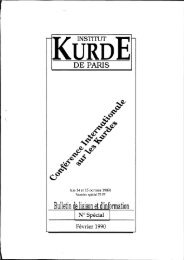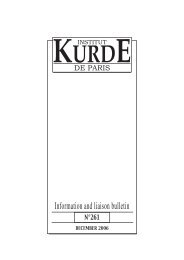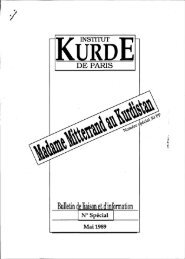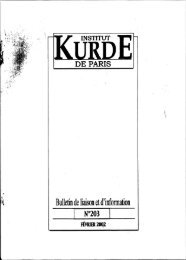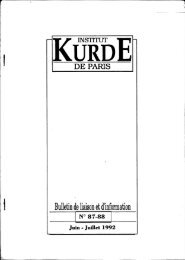Bulletin de liaison et d'information - Institut kurde de Paris
Bulletin de liaison et d'information - Institut kurde de Paris
Bulletin de liaison et d'information - Institut kurde de Paris
You also want an ePaper? Increase the reach of your titles
YUMPU automatically turns print PDFs into web optimized ePapers that Google loves.
Revue <strong>de</strong> Presse-Press Review-BerhevokaÇapê-Rivista<br />
Stampa-Dentro <strong>de</strong> la Prensa-Baszn Öz<strong>et</strong>i<br />
INTERNATIONAL HERALD TRIBUNE,<br />
TUESDAY, MARCH 21,2000<br />
'<br />
ECONOMIC SCENE<br />
Tehran Maps Path<br />
To a Free Mark<strong>et</strong><br />
By Philip Bowring<br />
Illlemaliimal Herald Tribulle<br />
TEHRAN - Iran started its new<br />
year this week, along with the third<br />
five-year social and economic <strong>de</strong>velopment<br />
plan. ' '<br />
Such plans are usually forg<strong>et</strong>table<br />
documents redolent of an earlier era<br />
of economics. But this one matters'<br />
because, although it has few <strong>de</strong>tailed<br />
targ<strong>et</strong>s, the plan outlines the reformist<br />
principles of the government un<strong>de</strong>r<br />
Presi<strong>de</strong>nt Mohammed<br />
Khatami.<br />
The plan comes<br />
into force just after<br />
reformers won con~<br />
trol of Parliament in<br />
elections they hope<br />
will speed Iran's<br />
transition from a<br />
tightly controlled,<br />
quasi-socialist<br />
economy into an open one where<br />
mark<strong>et</strong> forces and private ownership<br />
predominate. The economic strategy<br />
is also starting as the United States<br />
has begun to lift sanctions, which are<br />
likely to be gone altog<strong>et</strong>her within 18<br />
months.<br />
The Iranian economy has been in<br />
dire straits, averaging growth of 2<br />
percent over the past five years<br />
while the work force has been expanding<br />
at nearly 4 percent.<br />
Inflation has been well over 20<br />
percent a year. But social progress in<br />
health, education and other areas over<br />
the past <strong>de</strong>ca<strong>de</strong> has been impressive;<br />
now peOple want goods and jobs.<br />
With oil accounting for 80 per-<br />
,cent of Iran' s exports, the economy<br />
has suffered in part from low oil<br />
prices, which only recently have<br />
turned around.<br />
Other hindrances inclu<strong>de</strong> government<br />
<strong>de</strong>ficits fun<strong>de</strong>d by the central<br />
bank, an inefficient state industrial<br />
sector, multiple exchange rates, administered<br />
pricing for many commodities,<br />
negative real interest<br />
rates, indiscriminate consumer subsidies<br />
and a banking system that<br />
favors the state and the tax-exempt<br />
religious foundations that own<br />
many enterprises, including oncesplendid<br />
but now-dismal hotels.<br />
The goals of the plan inclu<strong>de</strong> a<br />
unified floating-exchange rate, cur-<br />
rent-account convertibility,<br />
positive<br />
rates of r<strong>et</strong>urn for<br />
savers, large-scale<br />
privatization, attraction<br />
of foreign<br />
investment, tax reform,<br />
reducing oil<br />
<strong>de</strong>pen<strong>de</strong>nce, encouraging<br />
labor intensive<br />
industries,<br />
targ<strong>et</strong>ing of subsidies to needy<br />
groups, and the reduction of government<br />
<strong>de</strong>ficits.<br />
Goals for the financial sector inclu<strong>de</strong><br />
the creation of credit institutions<br />
- including private ones -<br />
to comp<strong>et</strong>e with state-owned banks, ,<br />
the issue of <strong>de</strong>bt instruments to fund<br />
state <strong>de</strong>ficits, and the further <strong>de</strong>velopment<br />
of the Tehran Stock Exchange<br />
as a medium for privatization<br />
and new capital.<br />
The five-year plan was mostly<br />
formulated a year ago when low oil<br />
prices were forcing Iran to radically<br />
r<strong>et</strong>hink its economic system. There<br />
is a danger that higher prices will<br />
reduce the pressure for change, but<br />
political momentum is now strong.<br />
High export reveijues will m*e it<br />
easier to unify the exchange rate.<br />
Un<strong>de</strong>r the current system, rates<br />
,range from 1,750 ria,l_sto the dollar<br />
for imports of some food ànd other<br />
essentials to a free mark<strong>et</strong> rate of<br />
about 8,500 rials.<br />
Price reform will mean cutting'<br />
the consumption subsidies, which<br />
are given either from the budg<strong>et</strong> or<br />
through the exchange rate; both are<br />
the major cause of government <strong>de</strong>ficits,<br />
inflation and the consequent<br />
low level of savings.<br />
But it will not be easy because<br />
Iranians have become accustomed<br />
,to bread and gasoline costing a fraction<br />
of international levels. With<br />
jobs hard to find and a rapidly growing<br />
work force, the government will<br />
have to find a way of protecting the<br />
poor while reducing the subsidy<br />
bur<strong>de</strong>n without relying on oil.<br />
There is certainly now the the-<br />
'qr<strong>et</strong>ical will to open up the economy.<br />
But it will take time to over- ,<br />
comebureaucratic inertia, en'- ,<br />
trenched state enterprises and foundations<br />
and the socialist thinking<br />
,that always formed part of the Is-<br />
Iran's economic plan outlines the policies of<br />
Presi<strong>de</strong>nt Mohàmmed ,Khatami, whose<br />
reformist allies now dominate Parliament.<br />
Social progress in<br />
Iran has been<br />
impressive. But<br />
now, people want<br />
goods and jobs.<br />
lamie revolution in 1979.<br />
As in China, workers in old organized<br />
industries have job security<br />
and many benefits while the small<br />
scale, informal and rural workers<br />
have little.<br />
Privatization has long been on the<br />
agenda in Iran. But until recently it<br />
had been bogged down in constitutional<br />
and political disputes. Now<br />
it is moving again, with the ministry<br />
of industry publishing a schedule of<br />
sales of enterprises.<br />
With private capital in such short<br />
supply, privatization has often<br />
meant the sale of one state enterprise<br />
to another, or to a state bankinvestment<br />
company. But this process<br />
represents progress because the<br />
growing enterprises are more commercially<br />
min<strong>de</strong>d.<br />
A growing number companies are .<br />
also listed on the slack exchange,<br />
which provi<strong>de</strong>s a tax advantage and<br />
,requires the companies to be mo~e<br />
profit conscious.<br />
Some Iranian companies survive<br />
because of cheap credit, high tariffs<br />
and import bans. But many make<br />
good profits <strong>de</strong>spite these obstacles<br />
and will very likely show remarkable<br />
growth as economic reform<br />
proceeds.<br />
If the government moves quickly<br />
in carrying out the plan 's good intentions"<br />
gross domestic' product<br />
cO,uld easily grow 6 percent to 7<br />
percent annually in the next five<br />
years as Iran makes' uï:>for, lost<br />
time.<br />
58





